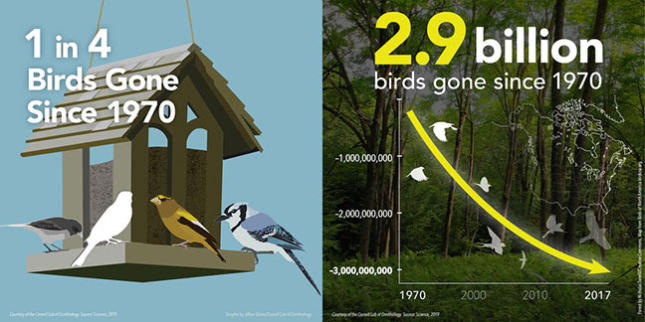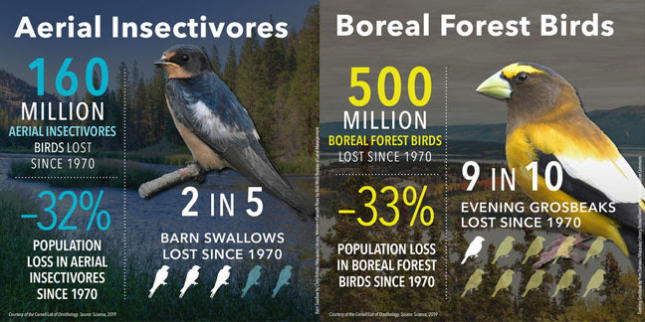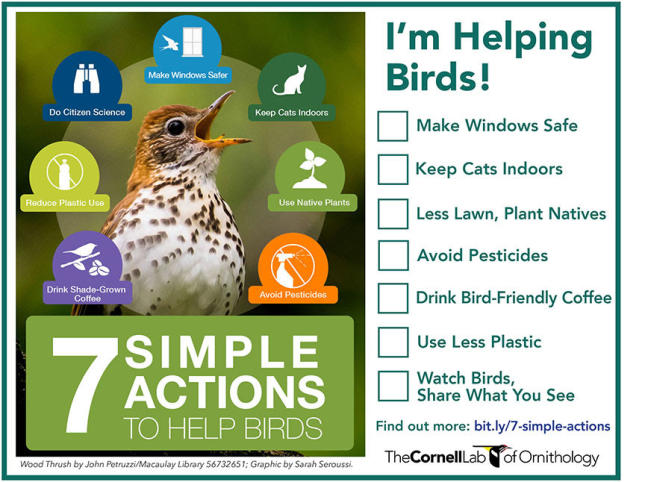Help Save the Songbirds
Research published in the journal Science, details how nearly 3 BILLION birds have been lost over the past 50 years. In less than a single human lifetime, an astounding 30% of our birds are gone forever!
Dan & Barbara, and other long-term bird watchers, have noticed the declines of species we used to always see or hear each year, and in some cases, Dan used to require students in his UO class to know species that now we only hear or see once a year, or maybe not at all.

Here are some quotes from the news release:
- "A study published ...September 19, 2019... in the journal Science reveals that since 1970, bird populations in the United States and Canada have declined by 29 percent, or almost 3 billion birds, signaling a widespread ecological crisis.
- "Multiple, independent lines of evidence show a massive reduction in the abundance of birds," said Ken Rosenberg, the study's lead author and a senior scientist at
the Cornell Lab of Ornithology and American Bird Conservancy. "We expected to see continuing declines of threatened species. But for the first time, the results also showed pervasive losses among common birds across all habitats, including backyard birds."
The study notes that birds are indicators of environmental health, signaling that natural systems across the U.S. and Canada are now being so severely impacted by human activities that they no longer support the same robust wildlife populations.
The findings show that of nearly 3 billion birds lost, 90 percent belong to 12 bird families, including sparrows, warblers, finches, and swallows - common, widespread species that play influential roles in food webs and ecosystem functioning, from seed dispersal to pest control.
Among the steep declines noted:
- Grassland birds are especially hard hit, with a 53-percent reduction in population - more than 720 million birds - since 1970.
- Shorebirds, most of which frequent sensitive coastal habitats, were already at dangerously low numbers and have lost more than one-third of their population.
- The volume of spring migration, measured by radar in the night skies, has dropped by 14 percent in just the past decade.
"These data are consistent with what we're seeing elsewhere with other taxa showing massive declines, including insects and amphibians," said coauthor Peter Marra, senior scientist emeritus and former head of the Smithsonian Migratory Bird Center and now director of the Georgetown Environment Initiative at Georgetown University. "It's imperative to address immediate and ongoing threats, both because the domino effects can lead to the decay of ecosystems that humans depend on for our own health and livelihoods - and because people all over the world cherish birds in their own right. Can you imagine a world without birdsong?"
See below to learn some ways WE can help, too.
We've been trying to forgo using plastic stuff as much as we can, but here is a list of additional ideas...and we carry the innovative, folding, cleanable straws called FinalStraw, too...
https://www.audubon.org/news/eight-easy-ways-reduce-your-plastic-waste

Here in Oregon, we're aware of a few instances where unseasonal weather (possibly climate change phenomena?) has caused big storms that led to die-offs of swallows who had yet to migrate. For many years in our old home off of 30th Avenue, we would get dozens of Evening Grosbeaks to our large tray feeder. Then, in the late 80s-early 90s, they were gone, never to return while we lived in that home. As a child in Pennsylvania, Barbara watched as thousands of Evening Grosbeaks descended form the trees along a Pocono stream after her great aunt and the young cousins had put out the dozens of feeders full of sunflower seed.
Here is additional information: https://youtu.be/cdzU84AyCdI To learn more, visit www.wbu.com/bring-birds-back
How can YOU Help Change this?
Here are some things YOU and your family can do to help, too.
https://www.3billionbirds.org/7-simple-actions
Click here for PDF on Ways To Help

PREVENT WINDOW STRIKES
- Apply Window Alert Clings to your windows.
- Effective for up to a year, they're easy to apply and need to be close together (3-4" apart ONLY!) on the outside of the window.
- They work because they're coated with an ultraviolet substance that we can't see but birds can...so they avoid it!
PREVENT CAT PREDATION
- Trim back low bushes where cats could hide to spring out to get birds at feeders on the ground.
- Keep your cats indoors like Barbara and Dan do. It will take about 6 months of effort and a cat litter box, but it can be done! (We'll write up a few notes on how we did it if folks want...)
- Put our BirdsBe Safe cat collars on outside cats...gift them to neighbors if it might help!
PLANT NATIVE BIRD-FRIENDLY PLANTS
- Ask for our bird-friendly native plant list, compiled by botanist-birder Bruce Newhouse.
- Choose plants that work in your yard that will attract birds, bees and other pollinators.
- AVOID use of pesticides at all costs! They kill bees and eliminate the birds' insect food!
USE LESS PLASTIC
- Avoid using single-use plastic: Invest in a few permanent straws, and keep food utensils in a package in your car...
- Come see our new Final Straw designs and colors
DRINK BIRD-FRIENDLY COFFEE (if you drink coffee)
- We will begin carrying Bird-friendly coffee if customers want it! We're looking into carrying it...

